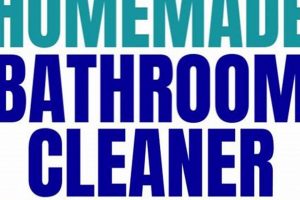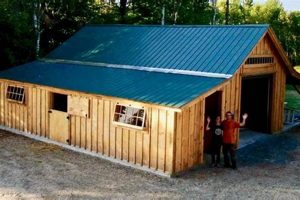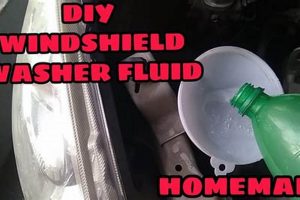The practice of addressing termite infestations through self-administered methods involves the application of various techniques and products by homeowners or property managers. This approach contrasts with professional pest control services and typically entails identifying termite activity, selecting appropriate treatments, and implementing them directly on affected areas. Examples include applying borate solutions to wood, using termiticide barriers around foundations, or deploying bait systems.
Implementing pest control measures independently offers potential cost savings and increased control over the treatment process. Historically, reliance on these methods has been driven by factors such as limited access to professional services, budgetary constraints, and a desire for greater autonomy in property maintenance. Effective implementation can lead to the preservation of structural integrity, reduced property damage, and a decrease in the long-term costs associated with termite infestations.
The subsequent sections will delve into the identification of termite species, an evaluation of available treatment options, a discussion of the associated risks and limitations, and guidelines for ensuring safe and effective application of these methods to minimize termite damage.
DIY Termite Treatment
Successful management of termite infestations through self-directed methods requires meticulous attention to detail and a comprehensive understanding of termite behavior and available treatment options. The following guidelines provide essential information for effective implementation.
Tip 1: Accurate Termite Identification: Correctly identifying the termite species is crucial for selecting the appropriate treatment. Subterranean, drywood, and dampwood termites require different strategies. Consult field guides or entomological resources for precise identification.
Tip 2: Thorough Inspection is Imperative: Conduct a comprehensive inspection of the property, including foundations, crawl spaces, attics, and wooden structures. Look for signs of termite activity such as mud tubes, frass (termite droppings), and damaged wood.
Tip 3: Soil Treatment Application: When addressing subterranean termites, create a chemical barrier in the soil around the foundation. Apply termiticides according to the manufacturer’s instructions, ensuring complete and consistent coverage. Note that specialized equipment may be required.
Tip 4: Wood Treatment for Direct Infestations: For infestations within wooden structures, apply borate-based solutions directly to the affected wood. These solutions penetrate the wood, creating a toxic environment for termites. Ensure thorough saturation.
Tip 5: Bait System Deployment: Termite bait systems can be effective in eliminating colonies. Place bait stations strategically around the property, monitoring them regularly and replenishing bait as needed. Consistent monitoring is vital for success.
Tip 6: Prevention Through Moisture Control: Termites thrive in moist environments. Eliminate sources of moisture around the foundation, repair leaky pipes, and ensure proper drainage. This reduces the attractiveness of the property to termites.
Tip 7: Wood-to-Soil Contact Elimination: Avoid direct contact between wood and soil, as this provides termites with easy access to structures. Maintain a clearance of at least six inches between wooden components and the ground.
Effective management necessitates meticulous planning, consistent monitoring, and diligent application of treatment strategies. Prioritizing accurate identification, thorough inspection, and preventive measures contributes to minimizing termite damage and safeguarding property integrity.
The subsequent section will address the potential risks associated with these methods, emphasizing safety precautions and proper handling of termiticides to protect both individuals and the environment.
1. Identification
Accurate identification of termite species is the foundational element for effective self-directed termite management. The success of DIY termite treatments hinges on selecting and applying the correct methods and products tailored to the specific termite infesting the structure. Misidentification can lead to ineffective treatment strategies, continued property damage, and wasted resources.
- Species-Specific Treatment Protocols
Different termite species, such as subterranean, drywood, and dampwood termites, exhibit distinct behaviors and habitat preferences. Subterranean termites, for example, require soil treatments to create a barrier against their access from the ground, while drywood termites necessitate direct wood treatments or fumigation alternatives. Misidentifying subterranean termites as drywood termites would result in ineffective treatment limited to the surface of the wood, failing to address the colony’s source in the soil.
- Understanding Termite Biology and Behavior
Identifying the termite species allows for a better understanding of its biology and behavior. This knowledge is essential for locating termite nests or entry points and predicting their movement patterns. For instance, Formosan subterranean termites are known for their aggressive behavior and large colony sizes, requiring more robust and comprehensive treatment plans compared to native subterranean termite species. The ability to differentiate between these species is crucial for choosing appropriate treatment intensity and frequency.
- Proper Product Selection and Application
Many termiticides and treatment methods are formulated for specific termite species. Using a product designed for subterranean termites on a drywood termite infestation is unlikely to be effective and can even be detrimental. Correct identification ensures the selection of appropriate products, application techniques, and dosages, maximizing the likelihood of successful termite control and minimizing potential environmental impact.
- Monitoring and Evaluation of Treatment Effectiveness
Accurate identification provides a baseline for monitoring the effectiveness of treatment efforts. After implementing DIY termite treatments, observing changes in termite activity or the presence of specific signs (e.g., mud tubes, frass) can indicate whether the treatment is working. If the initial identification was incorrect, the monitoring process would be based on flawed assumptions, leading to misinterpretations of the treatment’s efficacy.
Therefore, accurate termite identification forms the bedrock upon which all subsequent DIY termite treatment decisions are made. It ensures that resources are allocated effectively, the correct treatment strategies are employed, and the desired outcome of eliminating the termite infestation is achieved. Without this crucial initial step, DIY termite treatment efforts are highly susceptible to failure, resulting in continued property damage and potential economic loss.
2. Soil Treatment
Soil treatment forms a critical component in DIY termite management, particularly for subterranean termite infestations. Subterranean termites establish colonies in the soil and access wooden structures by building mud tubes. Therefore, creating a chemical barrier in the soil around the foundation serves as a primary defense. The efficacy of self-administered termite control hinges on the correct application of termiticides to the soil, ensuring a continuous and impenetrable barrier that prevents termite access. Failure to adequately treat the soil can result in continued termite activity and structural damage despite other treatment efforts.
DIY soil treatment typically involves trenching around the foundation and applying a liquid termiticide to the soil. This requires careful adherence to label instructions regarding concentration, application rate, and safety precautions. For example, improper mixing of the termiticide can render it ineffective, while inadequate trenching can leave gaps in the barrier, allowing termites to bypass the treatment. Furthermore, factors such as soil type, moisture content, and proximity to water sources can influence the effectiveness and longevity of the soil treatment. In regions with high termite pressure, supplemental treatments or professional assistance may be necessary to maintain adequate protection.
In summary, soil treatment is an indispensable aspect of many DIY termite strategies, playing a pivotal role in preventing subterranean termite infestations. Its effectiveness, however, is contingent upon precise execution, adherence to safety guidelines, and an understanding of site-specific conditions. Although soil treatments can provide a substantial level of protection, homeowners must recognize their limitations and be prepared to supplement these efforts with other methods or professional services when necessary to safeguard their properties against termite damage.
3. Wood Protection
Wood protection represents a critical facet of self-managed termite control efforts. Because termites consume cellulose-based materials, wooden structural elements within a building become primary targets. Effective strategies to safeguard wood are integral to preventing or mitigating termite damage. These strategies aim to create an environment inhospitable to termites, either by making the wood toxic or by physically preventing access. The absence of adequate wood protection measures renders a DIY termite treatment strategy significantly less effective, potentially leading to extensive property damage despite other control attempts. For instance, a homeowner might implement soil treatment around the foundation but neglect to treat exposed wooden beams, leaving an open pathway for termites to infest the structure.
Several wood protection methods are available for DIY applications. These include applying borate solutions directly to wood surfaces, which penetrates the wood fibers and creates a toxic barrier for termites. Other options involve using treated lumber during construction or renovation, which incorporates termiticides directly into the wood during the manufacturing process. Regular inspections of wooden structures, particularly in areas prone to moisture or soil contact, are also essential. Addressing water leaks promptly and ensuring proper ventilation in crawl spaces can further reduce the attractiveness of wood to termites. The efficacy of these methods depends on proper application and the specific characteristics of the wood, termite species, and environmental conditions. An example is the proper saturation of the wood during borate treatment, and addressing underlying moisture issues that exacerbate termite issues.
In conclusion, wood protection is a crucial element within a comprehensive DIY termite treatment approach. By implementing appropriate preventative and reactive measures, homeowners can significantly reduce the risk of termite damage and protect their investment. However, it is important to recognize that wood protection alone may not be sufficient to eliminate established termite colonies. A holistic approach that combines soil treatment, baiting systems, and moisture control, along with diligent monitoring, provides the best defense against termite infestations. The practical implications involve cost savings on repairs and structural integrity of the buildings.
4. Bait Application
Bait application, as a method of termite control, involves strategically placing palatable but toxic substances that termites consume and carry back to the colony, leading to its eventual elimination. This approach represents a potentially effective strategy within the scope of DIY termite treatment, offering homeowners a means to target entire colonies rather than just individual termites or localized infestations.
- Mechanism of Action
Termite bait systems typically consist of cellulose-based materials impregnated with slow-acting insecticides. Termites forage for food and readily consume the bait, which is then transferred throughout the colony through trophallaxis (social food sharing). The slow-acting nature of the insecticide allows it to spread widely before causing mortality, thus maximizing its impact on the entire termite population. This contrasts with contact insecticides that only affect termites directly exposed to the chemical.
- Bait Station Placement and Monitoring
Effective bait application requires careful placement of bait stations in areas of known or suspected termite activity. This often involves monitoring for termite foraging trails, mud tubes, or other signs of infestation. Regular inspection of the bait stations is crucial to ensure they remain active and that termites are consistently consuming the bait. The frequency of monitoring and replenishment depends on factors such as termite species, environmental conditions, and the size of the infestation.
- Limitations and Considerations
While bait application can be effective, it is not without limitations. Some termite species are more receptive to bait than others, and the presence of alternative food sources can reduce the effectiveness of the bait system. Furthermore, the success of baiting depends on the termites consistently consuming the bait over an extended period. Homeowners should be aware that bait application may require patience and persistence, and it may not always be a suitable solution for all termite infestations. Correct installation, monitoring, and patience are key. A slow kill is the purpose of baits.
- Integration with Other Treatment Methods
Bait application can be integrated with other DIY termite treatment methods, such as soil treatments and wood protection measures, to provide a more comprehensive approach to termite control. For example, a homeowner might use bait stations to target the main termite colony while simultaneously treating the soil around the foundation to prevent future infestations. This integrated strategy aims to address both existing termite populations and prevent new colonies from establishing themselves.
In conclusion, bait application offers a viable option within the framework of DIY termite treatment, particularly for homeowners seeking to eliminate entire termite colonies. However, succes
sful baiting requires careful planning, diligent monitoring, and an understanding of the limitations and considerations associated with this method. It is crucial to remember baits are best suited to control a larger problem over time, not instantly eliminate small amounts of termites.
5. Moisture Control
Moisture control is fundamentally linked to the efficacy of DIY termite treatment. Termites thrive in damp environments, and excess moisture creates conducive conditions for infestation. Elevated moisture levels in and around a structure soften wood, making it easier for termites to excavate and consume. Furthermore, standing water or consistently damp soil provides a readily accessible water source, essential for termite survival. Therefore, addressing moisture issues is not merely a preventative measure, but an integral component of any comprehensive termite control strategy. Ignoring moisture problems can render other treatments ineffective, as termites will continue to thrive regardless of applied termiticides or bait systems. For example, a homeowner might apply soil treatments to create a chemical barrier, but if a leaky pipe provides a constant source of moisture near the foundation, termites can circumvent the barrier and continue their infestation.
Elimination of moisture sources involves several practical steps. Repairing leaky plumbing fixtures, ensuring proper drainage away from the foundation, and improving ventilation in crawl spaces and attics are crucial. Removing standing water from around the property and correcting grading issues that cause water to pool near the foundation also contribute to a drier environment. In some cases, the installation of vapor barriers in crawl spaces or dehumidifiers in basements may be necessary to maintain acceptable moisture levels. Failing to address these moisture issues will counteract efforts made in applying DIY termite treatments and can negate these treatments over time. These steps prevent the conditions for termites to return after treatment.
In conclusion, moisture control is indispensable for successful DIY termite treatment. By actively managing moisture levels and eliminating conducive conditions, homeowners can significantly reduce the risk of termite infestation and enhance the effectiveness of other treatment methods. Ignoring this fundamental aspect undermines the long-term success of self-administered termite control, emphasizing the importance of a holistic approach to termite management. Maintaining a dry environment is a long-term solution against termites.
6. Preventative Measures
Implementation of preventative measures forms a cornerstone of effective DIY termite treatment strategies. These actions aim to reduce the likelihood of initial termite infestations and mitigate the severity of existing problems, enhancing the long-term success of any self-administered termite control program.
- Proper Construction Practices
Sound building practices, such as using treated lumber for critical structural components and maintaining adequate clearance between wood and soil, significantly reduce termite vulnerability. In new construction or renovations, pressure-treated wood resists termite damage, providing a lasting barrier. Ensuring a minimum 6-inch clearance between soil and wooden structures disrupts termite access routes, forcing them to build visible mud tubes that facilitate early detection.
- Regular Inspections and Maintenance
Routine property inspections, focusing on areas prone to moisture accumulation and wood-to-soil contact, allow for early detection of termite activity. Addressing minor issues like leaky pipes, clogged gutters, or improper drainage prevents the creation of conducive termite habitats. Early detection and prompt repairs limit the scope of potential infestations, simplifying subsequent control efforts.
- Landscape Management
Careful landscaping practices can minimize termite attraction. Removing dead wood and plant debris from around the foundation eliminates potential food sources. Directing irrigation away from the foundation prevents soil saturation, reducing termite access to moisture. Selecting termite-resistant mulch minimizes harborage opportunities near vulnerable structures.
- Strategic Use of Physical Barriers
Installation of physical barriers, such as stainless steel mesh or basaltic termite barriers, during construction can prevent termite access to structures. These barriers create an impenetrable obstacle, forcing termites to seek alternative routes or preventing them from reaching wooden components altogether. When properly installed, physical barriers offer a long-term preventative solution, minimizing the need for chemical treatments.
Integrating these preventative measures into routine property maintenance practices significantly reduces reliance on reactive termite treatments. By creating an environment less hospitable to termites, homeowners can decrease the frequency and intensity of DIY termite control efforts, promoting long-term structural integrity and minimizing the environmental impact of chemical applications. Proactive prevention serves as a far more cost-effective and sustainable approach to termite management than solely relying on reactive treatments after an infestation has taken hold.
DIY Termite Treatment
The following section addresses common inquiries regarding the practice of independent termite management. These answers aim to provide clarity and guidance for those considering self-directed termite control measures.
Question 1: What are the primary risks associated with self-administered termite treatment?
Potential risks encompass improper identification of termite species, ineffective application of treatments, exposure to hazardous chemicals, and structural damage resulting from inadequate control.
Question 2: How can accurate termite identification be ensured before commencing treatment?
Consulting field guides, entomological resources, or submitting samples to local extension offices can aid in precise identification. Distinguishing between subterranean, drywood, and dampwood termites is critical.
Question 3: What safety precautions should be observed when handling termiticides?
Wearing protective gear (gloves, masks, eye protection), adhering to label instructions regarding dilution and application rates, and ensuring adequate ventilation are paramount.
Question 4: How often should properties be inspected for termite activity?
Annual inspections are recommended, with more frequent monitoring in regions with high termite pressure or known infestations. Focus on areas prone to moisture and wood-to-soil contact.
Question 5: Are these methods suitable for all types of termite infestations?
These methods are generally more effective for localized or early-stage infestations. Extensive or widespread problems may necessitate professional intervention.
Question 6: How can the effectiveness of treatment be monitored?
Observing changes in termite activity (e.g., absence of mud tubes, cessation of frass production) can indicate treatment effectiveness. Continued monitoring is essential to detect recurrence.
Proper planning, diligen
t execution, and consistent monitoring are essential for successful application of termite control. Awareness of potential risks and limitations is equally important.
The subsequent section will explore the ethical considerations associated with termite management, emphasizing responsible practices that minimize environmental impact and protect non-target organisms.
DIY Termite Treatment
This discussion has outlined the various facets of self-directed termite control, encompassing identification, treatment options, preventative strategies, and associated risks. Key points include the importance of accurate termite identification, the need for proper application techniques, and the critical role of moisture management in long-term prevention. Ethical and environmental considerations demand a responsible approach, prioritizing targeted treatments and minimizing the use of broad-spectrum chemicals.
Effective implementation requires a commitment to continuous monitoring, diligent maintenance, and an informed understanding of the limitations inherent in self-administered methods. While offers the potential for cost savings and increased control, homeowners must carefully weigh their capabilities and resources before undertaking such projects. Failure to adequately address infestations can lead to significant structural damage and economic loss. Therefore, a thorough assessment of the situation and a willingness to seek professional assistance when necessary are paramount for responsible property stewardship.



![DIY Build: Circular Saw Crosscut Jig PDF Plans [Free] The DIY Hub: Creative Crafts, Repairs & Life Hacks DIY Build: Circular Saw Crosscut Jig PDF Plans [Free] | The DIY Hub: Creative Crafts, Repairs & Life Hacks](https://craftingdiycenter.com/wp-content/uploads/2025/07/th-5916-300x200.jpg)


![Diya Aur Baati Hum: Illuminate Your Home [DIY Guide] The DIY Hub: Creative Crafts, Repairs & Life Hacks Diya Aur Baati Hum: Illuminate Your Home [DIY Guide] | The DIY Hub: Creative Crafts, Repairs & Life Hacks](https://craftingdiycenter.com/wp-content/uploads/2025/07/th-5913-300x200.jpg)
